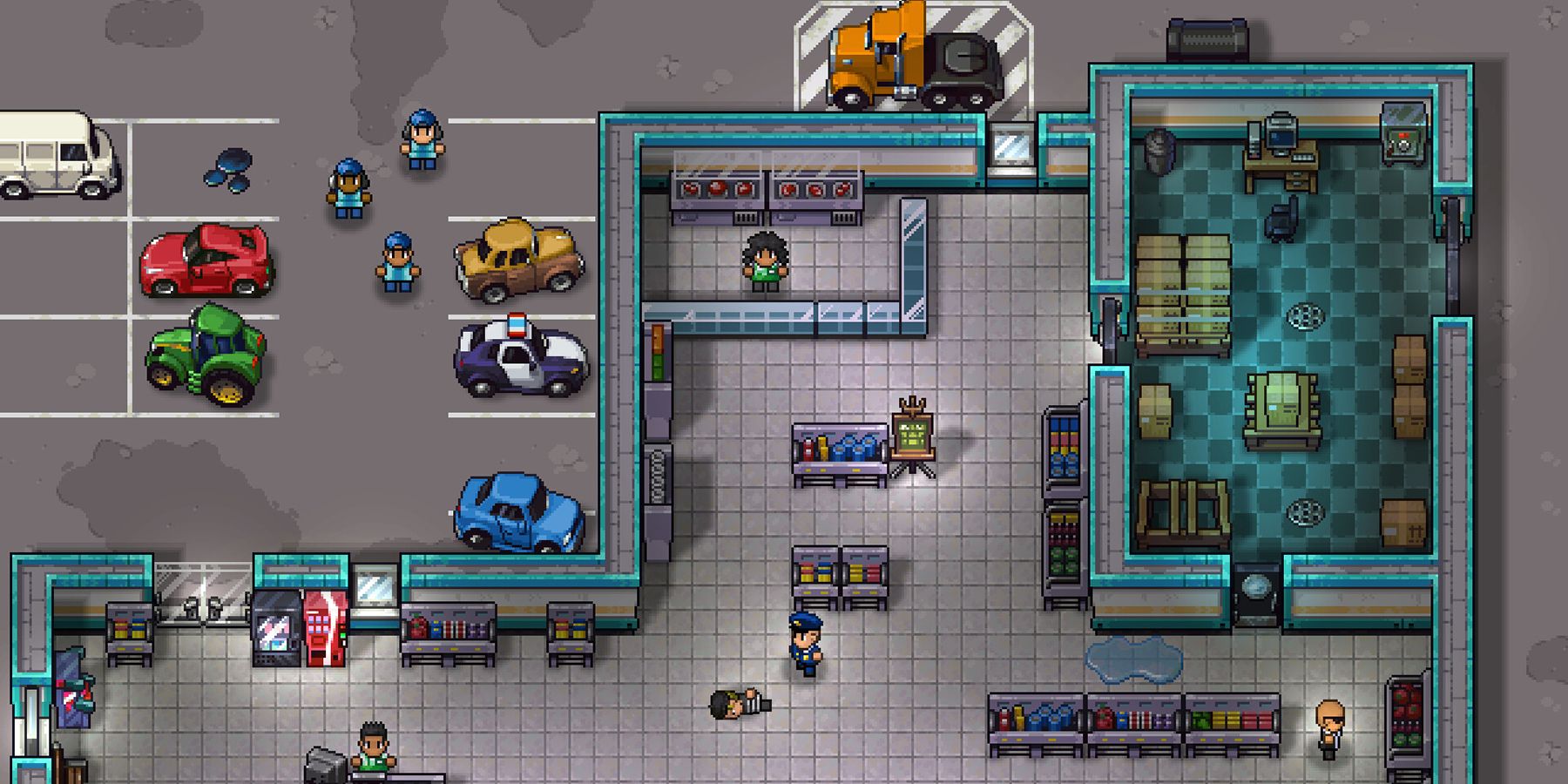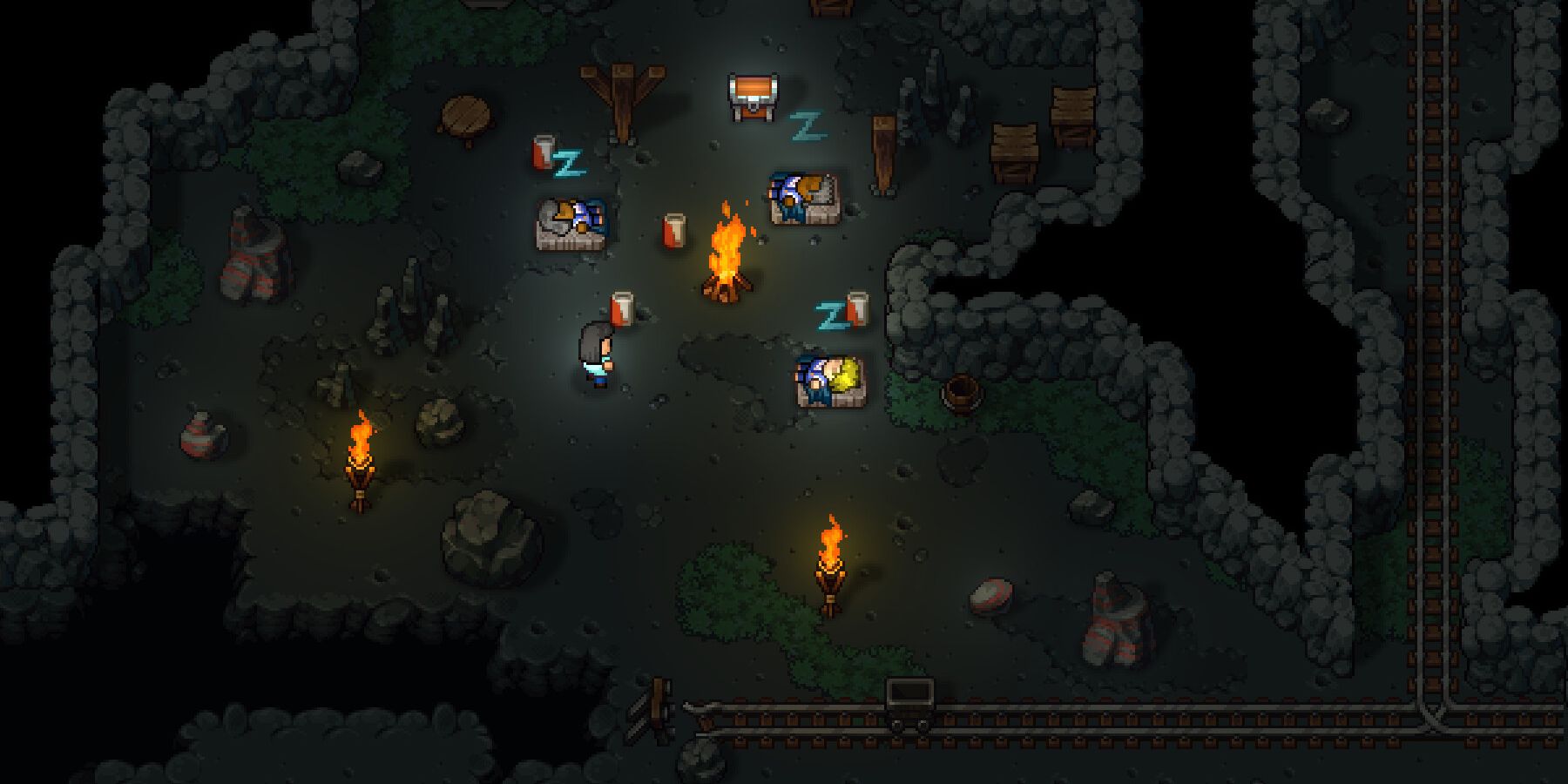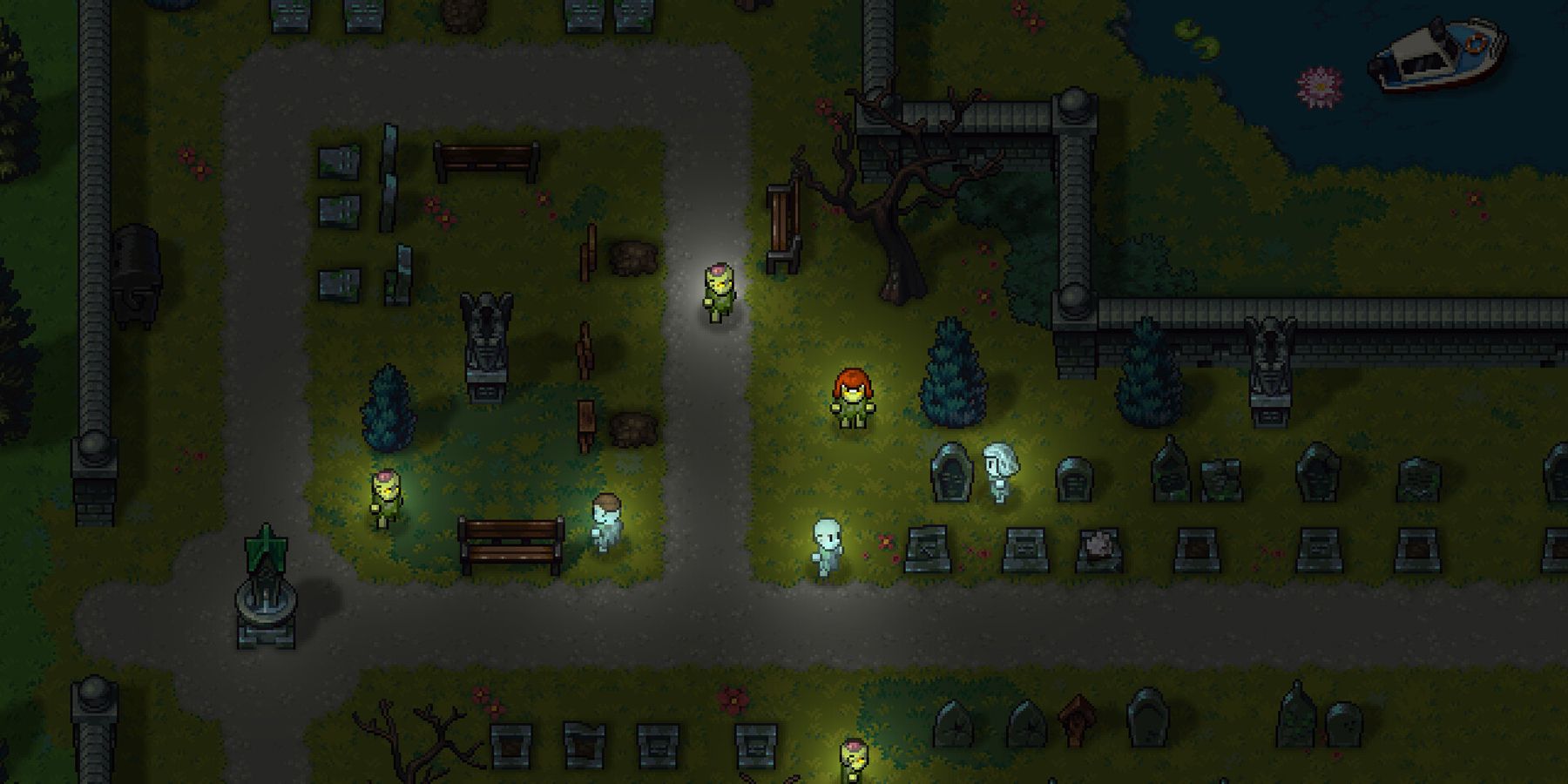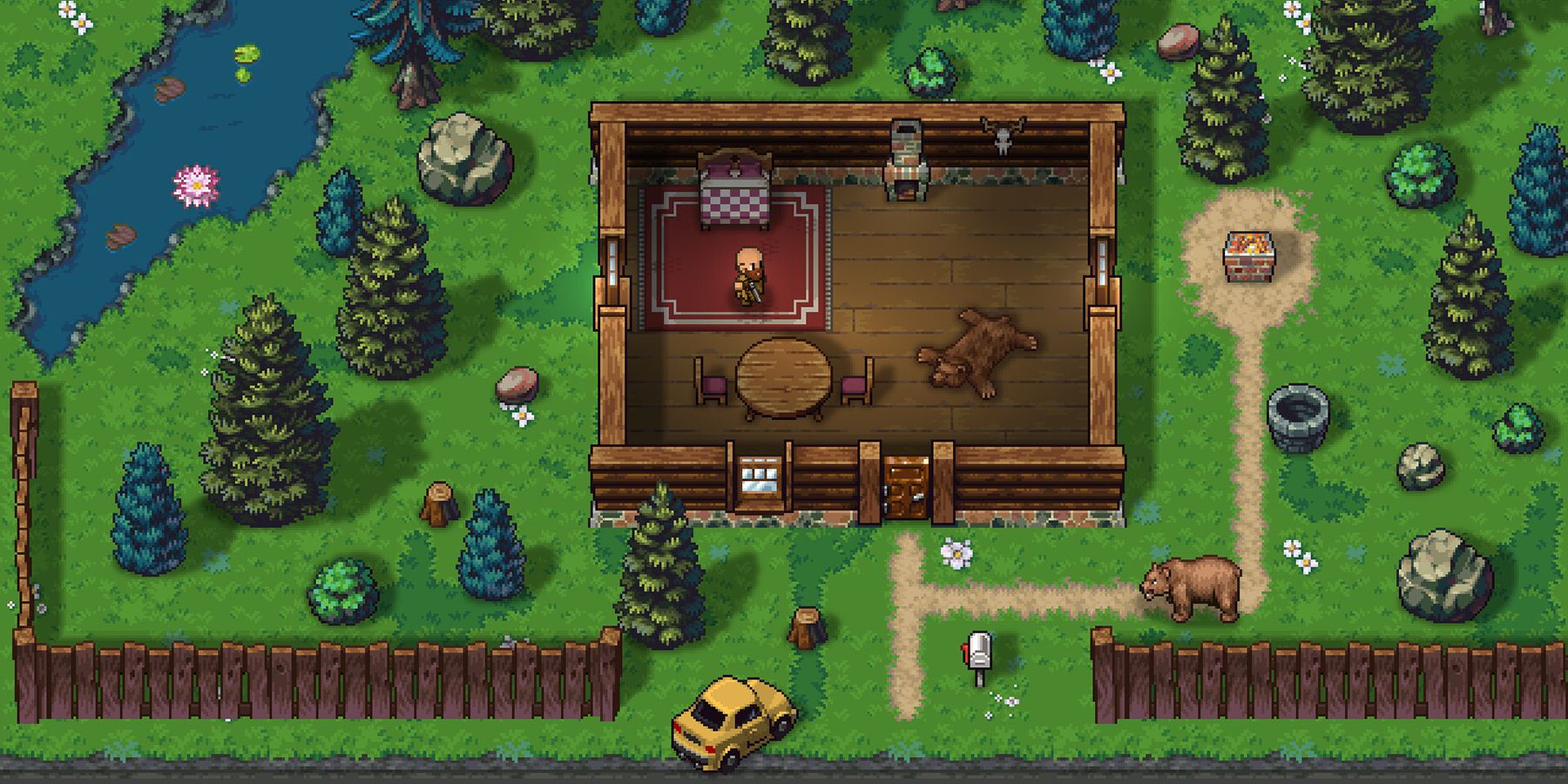Roguelikes come in a variety of flavors, and with Streets of Rogue 2, the genre will merge with the equally popular open-world format. While the original Streets of Rogue never attained the widespread recognition of Stardew Valley or Hades, it is an indie hit with near-uniformly positive reviews. Matt Dabrowski, the solo developer of the series, is hard at work on the sequel, rebuilding the original game's systems in procedurally generated open worlds.
Game Rant spoke to Dabrowski about the recently revealed title, touching on the new AI, graphics, and systems in the works as well as his long-term plans for the game. Interview has been edited for clarity and brevity.
Q: Can you briefly introduce yourself and share the Streets of Rogue character class you resonate with most strongly?
A: I’m Matt Dabrowski, the developer of Streets of Rogue. And in the original game, I preferred to play the Investment Banker, which isn’t a super popular character class. A lot of players seem to dislike it, actually. When I play, I tend to play really cautiously, and it forces me to play a little bit differently, because the Investment Banker is on drugs, and constantly needs to be finding ways to get his fix. And if he doesn’t, his skills decline before he can get that fix. So that adds a bit of time pressure on you.
Q: Can you briefly describe Streets of Rogue for players who are unfamiliar with the series?
A: I always struggle with giving an elevator pitch for this game. It really depends on who I’m talking to. Like, “Do you play video games? Okay, you do. How many video games have you played?” Most people don’t know what a roguelike is, but usually I describe it as a top down, Grand Theft Auto-style game with emergent gameplay elements. To quote its Steam page, you can fight, sneak, and hack your way through cities. So, an Enter the Gungeon-style game, meets Deus Ex, with the anarchy of Grand Theft Auto. It’s a roguelike with immersive sim features that goes completely insane.
Q: Streets of Rogue has received Overwhelmingly Positive reviews on Steam. Are players’ expectations for the sequel daunting?
A: Yeah. It’s pretty clear that people are expecting a lot from it from this game, partially because I promised a lot from it. But hopefully I can deliver on those promises! Still a ways to go before the game enters Early Access. My expectations for myself are also pretty daunting, but I am confident that I can deliver on them.
Q: Streets of Rogue 2 features procedurally generated open worlds as opposed to the linear progression of levels in the original. What motivated the change?
A: So partway through the development of the original game, I conceived the idea for this sequel. It was still in Early Access at the time, but I remember talking to the head of my publisher, TinyBuild, in late 2017 of what the sequel might be. And I said “well, it’s got to be open-world.”
And the reason for that was, I kind of felt constrained by the structure of the original game. It’s all level base, like roguelikes tend to be. I feel like there was only so much within that structure without breaking things. I can just keep adding more, and piling more and more on top of it, but I don’t know if that is actually good for the game or not. So the open world-structure is something I can see myself adding to for years and years to come. Something like Cataclysm: Dark Days Ahead, or Dwarf Fortress. Something like that, but a very light version of those kinds of things. Those are two of my inspirations, actually. Very emergent games with lots of cause-and-effect kind of stuff. But they are also very intimidating games, even for people who want to get into them. So, I figured if I could do a more emergent, open version of Streets of Rogue, that would be super cool. And that’s the reason I went the direction I did.
Q: Is the core game loop still focused around an objective checklist to beat the game? If so, will Streets of Rogue 2 feature an open-ended sandbox mode for players who want to experiment in the open world?
A: We haven’t actually figured out the structure yet. The structure is still in the works. I have ideas about what your ultimate goal or goals might be, and there will be a lot of different modes. I’m definitely going to be a sandbox mutator—that’s what we called them in the first game and I am probably going to do that again—but there will be a sandbox mutator where you don’t necessarily have to complete objectives.
In addition to that, there will be permadeath mutator for people who want a really hardcore challenge. Really, I want to be able to accommodate as many different playstyles as I can. But as for specific objectives and checklists, the details have yet to be worked out. That’s all I can say at this time.
Q: Vehicles and Farming are two major additions to the sequel: what kinds of rides will be available to players in Streets of Rogue 2 and how will the farming system compare to other titles that feature the mechanic?
A: Let me go into my files. We have a bunch planned right now, and a bunch of the car sprites have been completed. It pretty much runs the gamut from all the cars you could expect, you’ve got like junkers, fantasy cars, police cars, sedans, a tractor, a truck. We’ll have at least one water vehicle. If it exists in the world, we’re gonna try to get it in there. I think my pixel artist and I agreed upon about twenty to thirty vehicles.
As far as the farming system goes, it’s another one of those things where the details haven’t all been worked out. Farming games follow a pretty similar format where you plant crops, water them and watch them grow day to day, and then you can sell them. I do want to bring some Streets of Rogue flair to it. Let’s just say you’ll be able to grow some “unusual crops.” Some things that you might not expect, with unexpected effects as well. But that’s all I can say about it for now.
Q: Streets of Rogue 2 seems like it will emphasize item crafting and character customization as well. Can you give us an idea of the different categories of items players will be able to build?
A: Again, I haven’t really detailed any of this publicly just yet, and the reason for that is: it is still very much in the works. And if I say too much here… well, I don’t want to overpromise. Like farming, you should expect to be able to craft the typical things you’d expect from the genre, with some more outlandish Streets of Rogue elements. You could make a robot suit with a ghost blaster on it that is really good at killing ghosts. Or maybe you can use it to punch ghosts. This is something just off the top of my head. It’s hard to say at this point, but the sky’s the limit, because this is something I’m hoping to build upon for a long time. I just want to get a solid foundation first.
Q: Can you tease any of the new classes coming to Streets of Rogue 2? And will the class system see any major revisions?
A: This is kind of becoming a trend in this interview, but a lot of the content-related stuff is up in the air right now. I can’t promise any specific new classes at this time, but there will be some new classes for sure, and I’m trying to incorporate most of the classes from the original game in some form. As for character development, that will be completely revamped because the structure has changed.
In the original game, you choose between three random traits every time you got to a new level, but that’s not going to fly for a much bigger game that you are playing for a longer time. But yeah, can’t give the specifics just yet.
Q: Tell us a little bit about the upgraded NPC AI. What new kind of interactions will be possible?
A: I do. A lot of the AI upgrades have to do with the daily schedules. In the original game, we just kind of placed an NPC in the world and give them a specific job to do. Like to guard a place, or stand idle, or wander and they would stay that way for the remainder of the level. But since this is an open world game, it wouldn’t really fly to just have somebody standing at their shop indefinitely. So yeah, people will definitely go back to their home.
I’m not sure how much of this will be present in Early Access, because it can get really complicated, but I already have the ability for them to leave their job, get in their car, drive to a different town, go home and go to sleep, and come back next day. In addition to that, I’d also like to have NPCs do more entertaining things like chatting with each other, drinking at a bar, or reading a book. Again, this hasn’t been implemented yet, but it is something I want to get in there at some point in Early Access.
Q: In a recent update, you mentioned that you have been working on overhauling the pixel graphics and lightning system of the original game, but are determined to maintain the readability of the original title. Can you elaborate on that challenge?
A: It is something that my artist and I are working really hard on. My artist, Thomas Feichtmeir, is an amazing pixel artist. Somebody who has a real knowledge of what works and what doesn’t in these games, and a great technical knowledge as well. He can make something as detailed as you want. If you look at his twitter, you can see he’s done some amazingly detailed pixel art.
But there has to be this sort of balance, where things like background elements don’t stand out too much. And there are different little tricks you can do to help out with that. Things that are important are slightly lit up in the game. We need to have darker outlines on things that players should take notice of. Huge balancing act.
The original game didn’t have much detail compared to the sequel. If you look at the screenshots posted on Steam, you can see it is a much denser kind of world. But I think you can still look at it and read it easily. In the original game, you wanted to be able to look at a scene and parse it really quickly. Because there are so many options you have to deal with a given obstacle. Like, a hideout for example. You see the door, you see the air vent, you think “maybe I can put something in there,” but then you have to look for the air vents to see if they will actually affect the guards inside.
It was just a massive effort on our part. Everything from the shadow softness to the ambient lighting for different times of day was really, really carefully considered to get the look we wanted.
Q: The roguelike genre has seen explosive popularity lately, especially among indie designers. Why do you think that is? And what do you think the primary criteria for a satisfying roguelike is?
A: I suppose a big part of it is you can get a lot of content pretty cheaply from a programming standpoint. People have played Streets of Rogue for hundreds of hours, and I don’t think they would be doing that if they were playing the same levels. It’s really compelling, really interesting to create procedurally generated stuff and see the results of your work.
In terms of satisfying roguelikes, I think something that has a lot of variance every time you play. I’m trying to think of roguelikes I’ve played that haven’t been satisfying, and I think it comes down to this: if it feels repetitive, or randomized in a slightly different environment, it’s less satisfying. Challenge also. I think challenge is what keeps you coming back. You have to actually get good at roguelikes. Or at least the good ones. If you can beat the game on your second run, you have a problem as a developer.
Q: The original Streets of Rogue had an extremely colorful world, but the narrative was fairly consistent among all the character classes. Will the sequel feature more story elements?
A: Lore will still exist in the game, but I think the narrative portion of it took a backseat to other elements of the game. It was put in there, but I didn’t spend a lot of time thinking things though. Nothing in the world makes a whole lot of sense. Everybody in the world should be dead by the time they’re… I don’t know. There are all these dangerous elements, people are dying everywhere, there are no children. The sequel needs some kind of lore and background, and reasons for doing what you’re doing, but I’m not going to expand too much on it. There won’t be a deeply narrative main class. That is not the type of open world game this is. I wouldn’t say I’ll be expanding it so much as keeping it pretty comparable to the first.
Q: Tell us a bit about the music and SFX of Streets of Rogue 2. Is anything changing in the sequel?
A: A little bit. As far as composers go, the original game was composed and SFX by Craig Barnes. We wanted him to come back, but we weren’t able to make it happen. Very disappointing for a lot of fans from his work in the original game.
That said, I’ve been in talks with other composers and I think people will be pleased with the choices I’m making. We’re hoping to do more interactive music this time around. We haven’t really solidified the technical aspects of it yet, but we are hoping for more dynamic music, whether you are driving, entering a new city, or exploring caves.
I was watching a video about a company working on a game called Full Metal Furies, and they tried to add this really ambitious interactive music system into the game. And while it was really cool, players preferred to hear full songs in the end.
Q: What is the greatest development challenge you are facing in the sequel?
A: I’d say it is one hundred percent trying to fit all the systems from the original game into the big open world—as a technical challenge it’s pretty massive. I should have known better, but I did underestimate the amount of work that would go into the technical side of creating a large open world, especially given that I’m trying to give people the enormous amount of interactivity that I am. People think that things like farming and crafting are challenging, but I was able to fit in the first iteration of crafting in like a day. That’s actually a pretty easy thing to implement from a technical standpoint; but of course, it makes a big impact. The open world has been the continuous process over the last couple years.
Q: You mentioned your pixel artist, but have you brought on any new collaborators for the development of Streets of Rogue 2?
A: In addition to myself and Thomas, we brought on another collaborator to aid with modeling. Since the beginning of this year, Thomas and I have been working on all the art stuff, but we needed help with the cars. You can see in the screenshots, that the vehicles have twenty-four different angles to them, and we then pixel-ize those models.
Q: Do you have an estimated Early Access release date for Streets of Rogue 2 beyond 2023?
A: 2023 is all can say at the moment. It’s all I want to say, it’s all I can say, because if I specify a time I may end up disappointing people.
Q: Is there anything else you would like readers to know?
A: If this at all sounds interesting to us, give us a wish-list. That helps us out a lot. It helps with marketing at launch, and it’s what every developer strives for these days.
[END]
Streets of Rogue 2 is currently in development, with a projected Early Access release in 2023.




